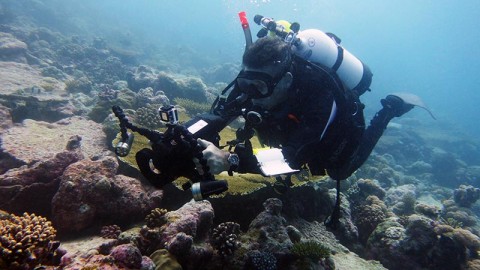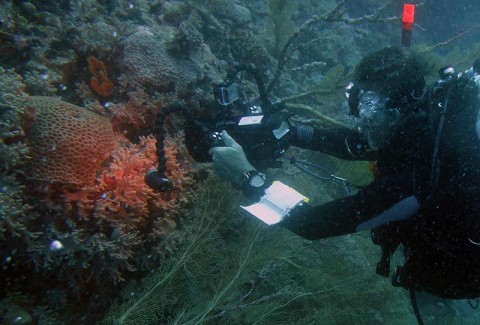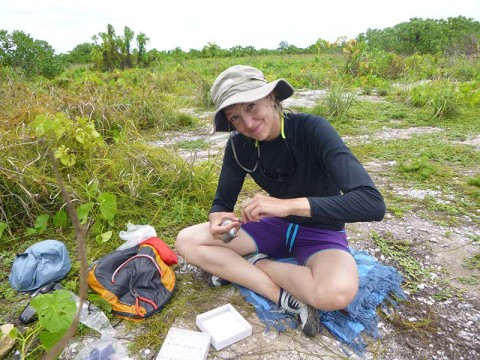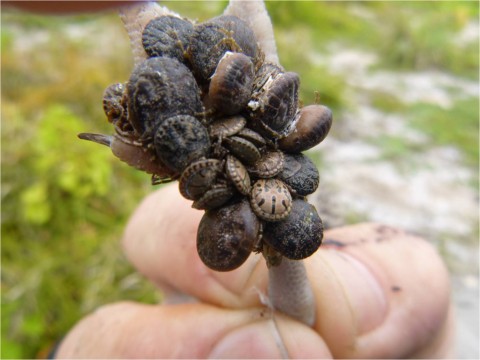BIOT Science Expedition 2014 - Back to diving… Day 8
Back to diving...

Sharks ate the whole expedition crew...I’m the only survivor and typing this with my remaining left hand. April Fool’s day and after a week the expedition crew are sufficiently settled for a unique community sense of humour to have developed. Banter is up and after a day out from diving yesterday everyone was full of energy and raring to get underwater again. All are more comfortable in the routine after a week on board and are happy that their work is going well. Today I followed John beneath the surface and gleaned a little more on what he is getting up to.

“One of the most important functions of the Chagos Marine Protected Area is that it serves as a reference site to measure change in the absence of direct impacts from human populations. However long term changes can be difficult to assess, especially if those scientists measuring the changes also change over the years! By recording what the reefs look using video, it is possible to compare sites across years.
Each day, Ronan Roche and I are selecting coral reef sites which I first visited in 2006. Our aim is to dive a similar profile and record on video what the reef looks like today, and to be able to compare these observations with those made in 2006. The video records are being carefully filed so that they can be compared in future years as well.
Coral cover on Chagos reefs has been assessed for more than 20 years, providing a valuable long term record of change over time in response to major environmental variables, such as warming events and bleaching induced mortality. Although photographs of many reef communities exist, these have been taken selectively and do not really present an objective record of the state of the reefs. High resolution video recorded across wide tracts of reef can show the state of that reef. A video archive of the structure of communities allows documentation of change and the identification of features that may not previously have been recorded in counts because their significance was not evident at that time. It also enables new generations of scientists to revisit reefs visually, and the video can be reanalysed to identify changes and to address questions of resilience and response.

10 minute sequences of video are being recorded over 5 m depth intervals on both seaward and lagoon sites, and these will be compared with video recorded in 2006. We are already noticing that many of the shallow table corals that grew rapidly at shallow depths following the 1997 mortalities, and were very prevalent in 2006 and now being replaced by a more diverse range of species, which can be expected to increase in biomass in subsequent years unless affected by further impacts. Many table corals appear to have died and are being dislodged by water movement and are falling down the reef slope. Last year, we saw that corals below about 15m depth in Salomon lagoon had died, probably due to warm, dense water at depth, and low circulation due to the reefs that surround most of the atoll. We have been delighted to see recovery of many of these corals in just 12 months. Some site displayed damage from plagues of the Crown of Thornes starfish, and we are now eager to revisit these sites to see whether they have recovered too. Such fast recovery shows that the coral reefs of Chagos are very resilient, and this is almost certainly because there are no direct impacts from humans."
The terrestrial work is also continuing and today measured impact of a different kind. Pete can elaborate from their trip ashore today.
“Today a Chagos bird mystery was solved and a pleasant surprise was had. The pleasant surprise was finding a new breeding island for Brown Booby. This species does not tolerate human disturbance at its breeding islands and the new location is a testimony to the control of access to certain islands in the Chagos. The mystery that was solved was why Sooty Terns desert breeding islands periodically in the Chagos.
My morning was spent assisting Liz with sea cucumber transects. The return deal was Liz was to assist me in the afternoon monitoring two islands that are IUCN categorised Important Bird Areas. On approaching the first of the IBAs it was immediately apparent there was no mass breeding episode happening on the island. The same thing happened when I visited this island in 2009. I suspected then that avian parasitic ticks were the cause of the breeding failure as I found a small number of chicks with ticks attached.

We moved on to the second island on which I had been told that in January of this year there were over 10000 breeding pairs present. Alarm bells rang when on approaching the island there were no “Wideawakes” calling over the island. As we walked in to what should have been the breeding area, instead of the cacophony normally associated with a Sooty Tern colony, all that was heard was the food-begging call of a small number of chicks. We decided to investigate. On walking around we noticed huge numbers of abandoned eggs, our calculations estimated 32000 pairs had tried to breed. Then we noticed some small chicks which we captured for examination. They had ticks. On further investigation we found that 26% of the chicks had ticks, some carrying as many as 20. Similar to what has been experienced in the Seychelles, Chagos Sooty Tern was experiencing breeding failure through excessive parasitic tick loads.

Although awful to witness, the fact that it was ticks causing Sooty Tern to desert breeding islands in the Chagos offered opportunities. The first was to assist other researchers who are working on gaining a better understanding of the impact and distribution of avian ticks on seabirds in the Indian Ocean. We collected a large sample (thanks Liz!) that will eventually find their way to colleagues in the Seychelles who specialise in this niche. The second opportunity was to review how we categorise what islands are ecologically “important.” Had these IBAs been assessed this year their true value would have been missed. In 2011 I suggested in press that most of the individual islands designated as IBAs should be classified as IBA in clusters on account that Sooty Terns did not nest on them all annually. This argument was expanded upon in a scientific publication edited by Professor Charles Sheppard. Today’s findings add more weight to the IBA cluster proposal, and give credible evidence why Sooty Tern do not nest on all breeding islands every year.”

